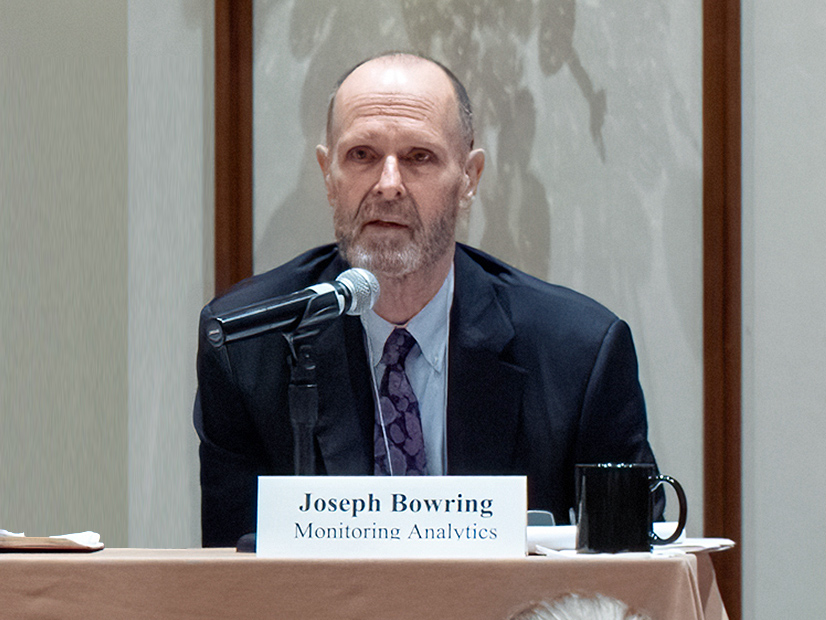Stakeholders Defer Vote on Generation Deactivation Issue Charge
VALLEY FORGE, Pa. — PJM’s Markets and Reliability Committee voted to defer a decision on an issue charge that would create a new senior task force to investigate changes to the generation deactivation process.
PJM and the RTO’s Independent Market Monitor are jointly sponsoring the problem statement and issue charge. (See “PJM and Monitor Present Generation Deactivation Issue Charge,” PJM MRC/MC Briefs: July 26, 2023.)
The scope includes discussion of the triggers for when PJM can offer a reliability-must-run (RMR) contract to a generator seeking retirement, the compensation for RMR resources and the timing of when a resource owner must notify the RTO of its intent to retire a unit.
Following feedback from the initial first read in July, the issue charge was revised to break out the discussion of resource compensation into its own phase to be considered prior to the other elements.
Presenting the proposal, PJM’s Paul McGlynn said the current compensation structure lacks clarity, as resources that opt not to use the formula rate for determining RMR compensation instead make FERC filings that can offer differing interpretations on cost recovery.
McGlynn envisions an additional RMR contract trigger for a resource that would create a shortfall in black start capability in a region if it were to retire.
PJM is seeking to lengthen the 90-day notice generators are required to provide before a desired deactivation date because the timeline leaves little time for planners to make necessary upgrades to ensure that the grid can remain reliable without the resource. Advanced knowledge of deactivations will be increasingly important given the scale of retirements PJM expects to see over the next decade, McGlynn said.
Stakeholders discussed PJM’s change to the issue charge, stating that expanding use of RMR contracts to maintain resource adequacy would be out of scope for the task force. Cost allocation for RMR contracts under the existing transmission violation trigger and changes to the capacity market also are listed as out of scope.
GT Power Group’s Tom Hyzinski said considering whether RA should be a rationale for offering an RMR contract could offer an additional tool if a large number of generators simultaneously decide to deactivate.
“We don’t want to approve an issue charge that prevents things from being discussed that need to be discussed,” Hyzinski said.
McGlynn said the RTO is already looking into improving the capacity market’s ability to ensure resource adequacy.
PJM Senior Vice President of Market Services Stu Bresler said there are backstop provisions in the tariff that allow additional capacity to be procured outside of the Base Residual Auction (BRA) cycle if the RTO falls below its targets.
Whether the process should preclude interactions with the capacity market was discussed at length both during the July meeting and on Thursday, with several stakeholders concerned the task force and its solutions could be fragmented from market changes being considered in other forums.
Paul Sotkiewicz, president of E-Cubed Policy Associates, said several areas of the issue charge were ambiguous and could lead to procedural arguments distracting from core issues. He and other stakeholders suggested amendments to clarify that language in the issue charge, which were adopted by PJM and the Monitor.
Vistra’s Erik Heinle said the revisions had improved the issue charge from its first read but that he believes the first phase should be RMR compensation and timing.
Monitor Joe Bowring said he would support breaking the issue charge into two separate stakeholder processes, with his focus being primarily on compensation.
Peak Market Activity Credit Changes Endorsed
Stakeholders endorsed tariff revisions to address the amount of credit market participants must maintain to satisfy their peak market activity (PMA) requirement, which is their highest exposure in the past year. (See “First Read on Peak Market Activity Credit Activity Proposal Expected in August,” PJM MRC/MC Briefs: July 26, 2023.)
The changes include redefining the PMA surplus and shortfall parameters, introducing minimum exposure and minimum transfer amounts to the tariff language and increasing the PMA reset from occurring semiannually to weekly. The reset reconciles over- and under-collateralization that occurs as energy prices and demand fluctuate.
The revisions also increase the number of permissible early payments from 10 to 13 to provide more flexibility, and the rolling invoice period was increased from three weeks to four.
PJM’s Yong Hu said staff had backcast numerous solutions and believe the proposal is optimal.
Denise Foster Cronin of the East Kentucky Power Cooperative (EKPC) said the utility had concerns with PJM’s initial proposal but that stakeholders and PJM were able to produce a strong compromise.
Bresler said because the proposal was endorsed by the Risk Management Committee (RMC) on Aug. 22 without objection, it would normally have been a consent agenda item for the MRC; however, staff are aiming to implement the tariff revisions before winter.
PJM Provides First Read on Reserve Certainty Issue Charge
PJM gave a first read of an issue charge and problem statement that seeks to address several areas of the reserve market, largely to address a decline in the response rate since the two tiers of reserves were consolidated in a market overhaul implemented Oct. 1. (See “PJM Seeks Stakeholder Process on Reserve Certainty,” PJM MRC/MC Briefs: July 26, 2023.)
Since presenting the issue charge to the MRC in July, PJM has revised the timeline laying out the order in which it seeks to address each of the work areas and added more education on the topics. The bulk of the immediate needs would be initiated upon approval of the issue charge, with an expected duration of six to nine months, followed by discussion on the longer-term items expected to take 12 to 18 months. Also, several changes were made to the work areas.
The immediate needs are reserve performance and penalties, aligning the offer structure with fuel procurement, deployment, and ensuring that procurement reflects system need. Longer-term needs include the eligibility requirements for reserve resources and incentivizing flexibility to meet system needs.
Bowring said he think the out-of-scope portion of the issue charge — which would allow PJM to prevent discussion of changes that could impact the RTO’s “ability to maintain reliability and compliance with NERC standards” — should be more specific and could be used by PJM to curtail discussion.
Bowring said PJM has previously made such assertions in response to participants, including the IMM, who disagreed with PJM’s approach.
“No one will propose changes that they believe will reduce reliability or compliance with NERC standards. The issue is how best to maintain reliability and compliance. There are multiple paths to those objectives. The ability to discuss options should not be arbitrarily limited,” he said.
The declining reserve response rate led PJM to increase its reserve requirement by 30% in May, overriding stakeholder objections. The Monitor at the time objected that the change was not needed and not supported by the data. PJM’s Donnie Bielak said the issue charge is intended to produce a permanent solution that is more satisfactory for stakeholders. (See “Stakeholders Reject PJM Synch Reserve Manual Change; RTO Overrides,” PJM MRC/MC Briefs: May 31, 2023.)



